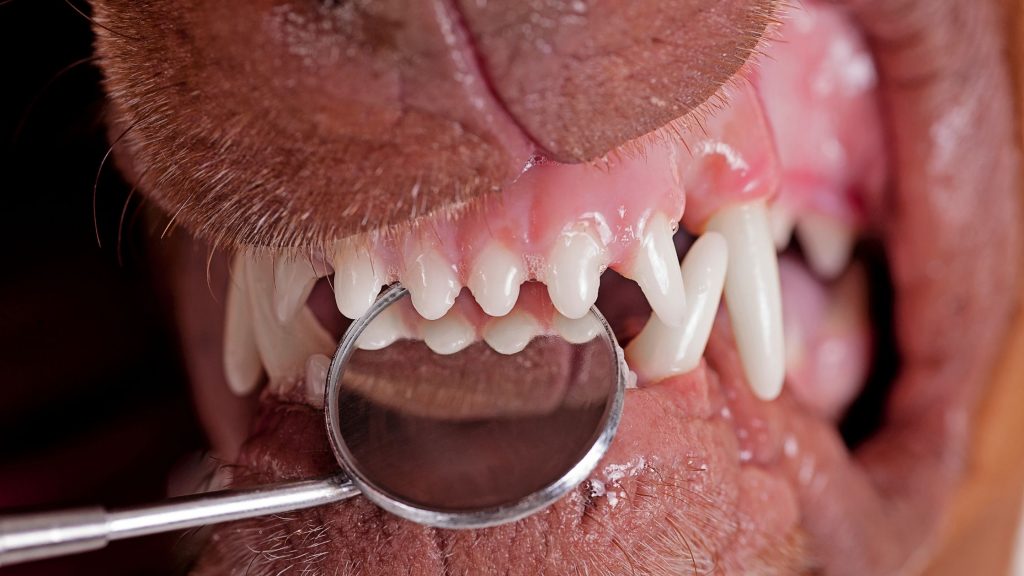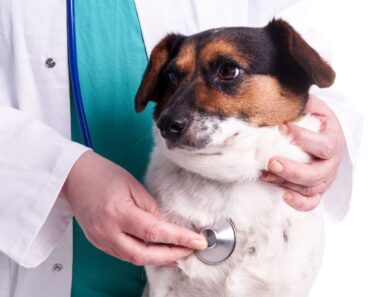During a recent vet visit with my two dogs, I noticed a poster hanging on the wall titled “10 Most Common Health Conditions in Dogs.” It was a list curated by Nationwide Pet Insurance and I found it to be an incredibly valuable resource. While the poster was simply a bullet-point list of conditions with no explanation of each issue, it inspired me to create a more in-depth resource for you!
1. Allergies
Just like we can suffer from seasonal allergies, so can our dogs. When it comes to allergy symptoms, us humans typically experience respiratory symptoms. Dogs, on the other hand, tend to experience skin issues. You might see your dog:
- Intensely itching, scratching, and rubbing
- Licking and biting at skin and paws
- Red and inflamed paw pads, from excessive licking and chewing
- Brown saliva stains on paw pads due to excessive licking
- Hair loss and hot spots, from all the scratching and rubbing
- Shaking head and ears: Ears can itch and/or become infected
- A yeasty smell: Be alert for any odors, open wounds, or skin breakdown from the excessive licking and chewing. These can be signs of infection and will need to be looked at by the vet.
- Runny nose and watery eyes can be present, but less frequently
Identifying and addressing the allergen source, along with consulting a veterinarian for appropriate treatment, can help manage and alleviate the discomfort for our furry friends. Find out more about allergies in dogs HERE.

2. Ear Infection
Growing up with six poodles, I’m no stranger to doggy ear infections. They’re especially common for dogs with floppy ears. No matter how many you may have dealt with, though, it’s always upsetting to watch your dog whimper as he feverously scratches away at his ear. Symptoms of an ear infection include:
- Pain and discomfort
- Head tilting or shaking
- Scratching
- Brown, reddish-brown, or yellowish discharge
- Smelly ears
- Swollen outer ear
- Reddened ear canal
If your dog has an ear infection, a vet visit is warranted. Ear infections will not go away without treatment and can progress to permanent damage including hearing loss and deafness. For more on ear infections, the types, common causes, and prevention, check out my article, “5 Tips To Prevent Ear Infections In Dogs,” HERE.

3. Non-Cancerous Skin Mass
Non-cancerous skin masses, such as lipomas, are often observed in older dogs. While they are generally harmless, any new lump or bump should be evaluated by a veterinarian to rule out any potential health risks. The key is to know what’s normal for your pooch so you can easily catch anything new/unusual. During a quiet time when you’re just sitting around and stroking your furry kid, run your hands up and down his head, back, belly, neck, and underarms so you can identify any lumps, bumps, or growths that might be there. If you find anything suspicious, have your vet check it out.

4. Diarrhea
Doggy diarrhea … what can I say … it happens! It’s common and can have numerous causes, ranging from a minor issue (like dining on too much grass) to something very serious (like parasites and life-threatening viruses). Diarrhea is a symptom that something else is going on. Before you can even think about treating doggy diarrhea, it’s important to try and figure out the cause. In general, a single bout of diarrhea in dogs shouldn’t cause too much concern. However, if your dog has any other symptoms (like on the following list) then something serious may be going on that needs to be diagnosed and treated.
- Bloody diarrhea
- Decreased appetite
- Vomiting
- Fever
- Lethargy and weakness
- Dehydration
Read all about diarrhea in my full article “Poop Problems: What You Should Know About Dog Diarrhea,” HERE

5. Vomiting
If you’re a dog parent, at one time or another, you’ve probably found a pile of dog vomit on the floor. Your dog may have eaten too quickly, run around too soon after a meal, or eaten something that didn’t agree with him. Although most times it’s nothing to worry about, vomiting can be a warning sign of something serious. So, if your pooch pukes, you need to try and figure out why. Ask yourself: Did he vomit multiple times within a few minutes or has he been vomiting throughout the day? It all matters. Also, what does it look like? Vomit can be a range of different colors, textures, and odors. If your dog does wind up needing a vet visit, the more details you can supply – the more helpful it will be. Check out my full article, “Dog Vomit Guide: What Your Dog’s Puke Means,” HERE. It provides information on what you need to know when your dog vomits!

6. Skin Infections
Skin infections are a pain in the tail for our furry family members. They can occur due to factors like poor hygiene, allergies, underlying health conditions, or exposure to environmental irritants. Scratching, licking, or chewing at the affected area are common signs that a dog may be dealing with a skin infection. It’s essential to consult with a veterinarian if you suspect your dog has a skin infection. A proper diagnosis will help determine the specific cause of the infection, allowing for targeted treatment, which may include topical or oral medications, medicated shampoos, and addressing any underlying issues contributing to the infection.

7. Inflammation/Infection of Anal Sacks
All dogs—no matter their size, gender or breed—have two small sacs located on each side of their anus, sitting at around 4 and 8 o’clock. You’ll hear them referred to as anal sacs or anal glands. Their purpose? They produce an oily and smelly excretion that is used to identify and mark territory. Get this—each dog’s excretion has its own unique and distinct scent. According to the AKC, this fishy-smelling fluid “tells other dogs such things as your dog’s sex, health, and approximate age.”
Usually, your dog’s anal glands drain themselves when your pooch passes a healthy bowel movement of normal consistency. However, poor diet or an inherited biological problem can cause something called Anal Sac Disease (that’s the term used to describe problems with the anal glands).
When anal glands don’t empty properly, they can become inflamed, impacted, and abscessed. This causes a lot of discomfort for your canine. According to Embrace Pet Insurance, “About twelve percent of dogs (and even some cats) have issues with their anal glands.”
Read my full article on Anal Glands, “Why Does My Dog Smell Like Fish?” HERE
8. Arthritis
To put it simply, arthritis is inflammation of the joints. Like with humans, there are actually several different types of arthritis that can affect dogs — osteoarthritis (AKA degenerative joint disease) is the most common.
According to Dr. Karen Becker: “20 percent of dogs over a year of age, or 1 in 5 canine companions, will develop degenerative joint disease. And certain large breeds — including Golden and Labrador Retrievers, German Shepherds, Newfoundlands and St. Bernards — have a 70 to 80 percent chance of developing the disease. That’s 4 out of every 5 dogs of those breeds.”
The most common joints in your dog’s body to be affected by osteoarthritis include hips, lower back, elbows, knees, wrists, shoulders, and ankles. Weight management, regular exercise, and joint-nourishing supplements can contribute to managing arthritis and improving the quality of life for our aging canine companions.

9. Dental Disease
How would you rate your dog’s dental health on a scale of 1 being the worst to 10 being the best? Unfortunately, the majority of adult dogs would be ranked toward the low end of the scale. In fact, according to Dogs Naturally, more than 70 percent of dogs and cats will suffer from periodontal disease (AKA gum disease) by the time they’re just two years old. Unless you take action early on, your dog’s teeth will just worsen with age.
Periodontal disease can have devastating effects on your dog’s mouth and general health. It can cause:
- In the mouth
- Stinky breath
- Pain
- Bleeding gums
- Loose teeth and tooth loss
- Bone loss
- Systemically
- Heart Disease
- Liver Disease
- Kidney Disease
For more on Dental Health, check out these 2 articles:

10. Bladder Infection
Bladder infections can be caused by bacteria traveling up the urethra into the bladder. Female dogs are more prone to bladder infections due to their shorter urethra, but males can also be affected. Underlying issues such as bladder stones or anatomical abnormalities can contribute to the development of bladder infections.
Common signs of a bladder infection in dogs include:
- Frequent Urination: Dogs may need to urinate more frequently than usual.
- Straining to Urinate: Dogs may appear to have difficulty or discomfort while trying to urinate.
- Urinating in Small Amounts: Even though a dog may try to urinate frequently, only small amounts of urine may be produced.
- Blood in Urine: In some cases, there may be blood visible in the urine.
- Urinary Accidents: Dogs may have accidents indoors, especially if they are unable to hold their urine due to the infection.
If a bladder infection is suspected, contact your vet for a checkup.








